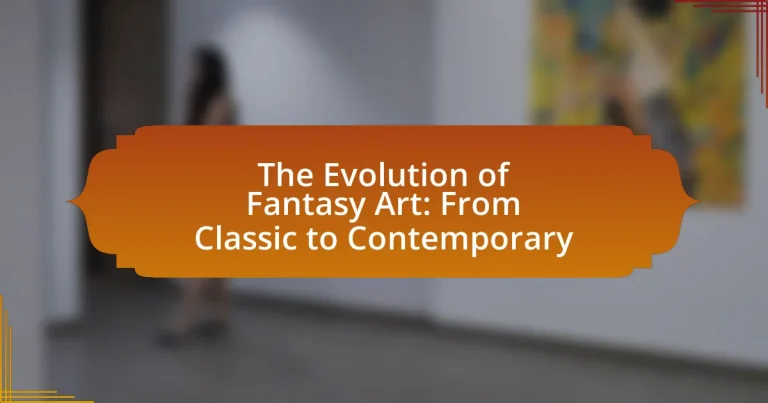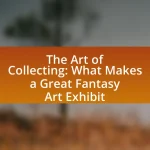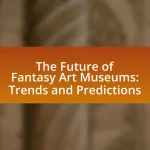The article examines the evolution of fantasy art, tracing its development from early mythological illustrations to contemporary digital creations. It highlights key historical periods, including the Romantic period, the Golden Age of Illustration, and the modern digital era, emphasizing how cultural influences and technological advancements have shaped the genre. The discussion includes notable artists, defining characteristics of classic and contemporary styles, and the impact of literature and popular culture on fantasy art. Additionally, it explores current trends, emerging styles, and practical tips for aspiring artists, providing a comprehensive overview of the dynamic landscape of fantasy art.
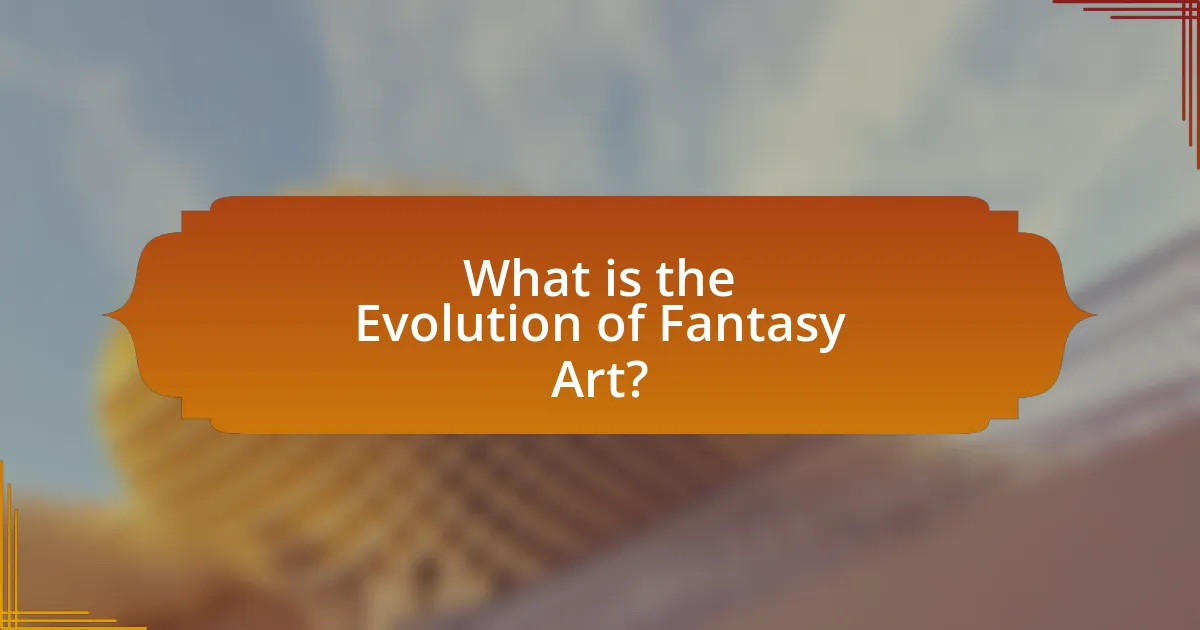
What is the Evolution of Fantasy Art?
The evolution of fantasy art spans from early mythological illustrations to contemporary digital creations. Initially, fantasy art emerged in the form of medieval manuscripts and paintings, where artists like Gustave Doré depicted scenes from literature and mythology, influencing the genre’s visual language. The 19th century saw the rise of Romanticism, with artists such as John William Waterhouse and Arthur Rackham incorporating fantastical elements into their works, further expanding the genre’s scope.
In the 20th century, fantasy art gained prominence through the works of illustrators like Frank Frazetta and Boris Vallejo, who popularized a more dynamic and muscular style, often associated with pulp magazines and fantasy novels. The advent of digital technology in the late 20th and early 21st centuries revolutionized fantasy art, allowing artists to create intricate and immersive worlds using software like Photoshop and 3D modeling tools. This shift has led to a diverse range of styles and techniques, making fantasy art more accessible and varied than ever before.
Overall, the evolution of fantasy art reflects broader cultural shifts and technological advancements, showcasing a continuous dialogue between tradition and innovation.
How has fantasy art changed over time?
Fantasy art has evolved significantly over time, transitioning from traditional forms in the early 20th century to diverse contemporary styles. Initially, fantasy art was heavily influenced by mythology and folklore, with artists like Arthur Rackham and Frank Frazetta creating detailed illustrations that captured the imagination. As technology advanced, particularly with the advent of digital tools in the late 20th century, artists began to explore new mediums and techniques, leading to a broader range of styles and themes. The rise of video games and films further popularized fantasy art, resulting in a fusion of visual storytelling and interactive experiences. This evolution reflects changing cultural narratives and the increasing acceptance of fantasy as a legitimate art form, evidenced by the inclusion of fantasy art in major exhibitions and galleries worldwide.
What are the key historical periods in fantasy art?
The key historical periods in fantasy art include the Romantic period, the Pre-Raphaelite movement, the Golden Age of Illustration, and the contemporary digital era. The Romantic period, spanning the late 18th to mid-19th century, emphasized emotion and nature, influencing artists like Caspar David Friedrich. The Pre-Raphaelite movement, active in the mid-19th century, focused on medieval themes and vibrant colors, with artists such as Dante Gabriel Rossetti. The Golden Age of Illustration, from the late 19th to early 20th century, featured artists like Arthur Rackham and Howard Pyle, who brought fantasy to life through illustrated books. Finally, the contemporary digital era, beginning in the late 20th century, has revolutionized fantasy art through digital tools and platforms, allowing artists to create immersive worlds and characters. Each of these periods has significantly shaped the development and perception of fantasy art throughout history.
How do cultural influences shape fantasy art styles?
Cultural influences shape fantasy art styles by providing thematic elements, aesthetic preferences, and narrative structures that reflect the values and beliefs of different societies. For instance, Japanese fantasy art often incorporates Shinto and Buddhist motifs, resulting in unique representations of nature and spirituality, as seen in works like Yoshitaka Amano’s illustrations for the Final Fantasy series. Similarly, Western fantasy art frequently draws from medieval European mythology and folklore, evident in the works of artists like Frank Frazetta, who depicted heroic figures and epic battles inspired by Arthurian legends. These cultural contexts not only inform the visual language of fantasy art but also influence the storytelling techniques and character archetypes that resonate with audiences, demonstrating the profound impact of cultural heritage on artistic expression.
What are the defining characteristics of classic fantasy art?
Classic fantasy art is characterized by its imaginative and otherworldly themes, often depicting mythical creatures, epic landscapes, and heroic figures. This genre typically employs vibrant colors and intricate details to create a sense of wonder and escapism. Notable examples include the works of artists like Arthur Rackham and Frank Frazetta, who utilized elaborate line work and dynamic compositions to convey movement and emotion. The use of symbolism and allegory is also prevalent, reflecting cultural myths and legends, which further solidifies its place in art history.
What themes are prevalent in classic fantasy art?
Classic fantasy art predominantly features themes of heroism, mythology, and the supernatural. These themes are often illustrated through epic battles, legendary creatures, and enchanted landscapes, reflecting the cultural narratives and folklore of the time. For instance, the works of artists like Arthur Rackham and Frank Frazetta showcase heroic figures engaged in quests, drawing from mythological sources such as Greek and Norse legends. Additionally, the presence of magical elements, such as wizards and mythical beasts, emphasizes the allure of the fantastical and the exploration of the unknown. This thematic focus not only captures the imagination but also serves as a reflection of societal values and aspirations during the periods in which these artworks were created.
Who are the notable artists from the classic era?
Notable artists from the classic era include Leonardo da Vinci, Michelangelo, and Raphael. Leonardo da Vinci, known for masterpieces like the “Mona Lisa” and “The Last Supper,” exemplified the use of perspective and human emotion in art. Michelangelo, celebrated for his sculptures such as “David” and the Sistine Chapel ceiling, showcased the human form’s beauty and complexity. Raphael, recognized for his harmonious compositions and use of color in works like “The School of Athens,” contributed significantly to the High Renaissance style. These artists are foundational figures in art history, influencing countless generations and shaping the evolution of artistic expression.
What distinguishes contemporary fantasy art from its classic predecessors?
Contemporary fantasy art is distinguished from its classic predecessors primarily by its incorporation of modern themes, diverse cultural influences, and advanced digital techniques. While classic fantasy art often focused on mythological and medieval themes, contemporary works frequently explore contemporary societal issues, personal identity, and global cultures, reflecting a broader range of human experience. Additionally, the use of digital tools and platforms has revolutionized the creation and distribution of fantasy art, allowing for greater experimentation in style and accessibility to a wider audience. This shift is evident in the rise of digital artists who utilize software like Photoshop and Procreate, contrasting with the traditional painting methods prevalent in earlier periods.
How has technology influenced contemporary fantasy art?
Technology has significantly influenced contemporary fantasy art by enabling artists to create more intricate and immersive works through digital tools and platforms. Digital painting software, 3D modeling programs, and virtual reality environments allow artists to experiment with new techniques and styles that were not possible with traditional media. For instance, programs like Adobe Photoshop and Blender have become essential in the creation of detailed fantasy landscapes and characters, facilitating a level of precision and creativity that enhances visual storytelling. Additionally, online platforms and social media have expanded the reach of fantasy artists, allowing them to showcase their work to a global audience and collaborate with other creators, thus fostering a vibrant community that continuously pushes the boundaries of the genre.
What new themes and styles have emerged in contemporary fantasy art?
Contemporary fantasy art has seen the emergence of themes such as environmentalism, diversity, and mental health, alongside styles that incorporate digital techniques and mixed media. Artists increasingly explore the relationship between nature and fantasy, reflecting concerns about climate change and ecological preservation. Additionally, the representation of diverse cultures and identities has become prominent, showcasing a broader range of characters and narratives. The integration of digital tools allows for innovative visual effects and interactive experiences, while mixed media approaches combine traditional and modern techniques, enhancing the depth and complexity of the artwork. These developments signify a shift towards more inclusive and relevant storytelling in the fantasy genre.
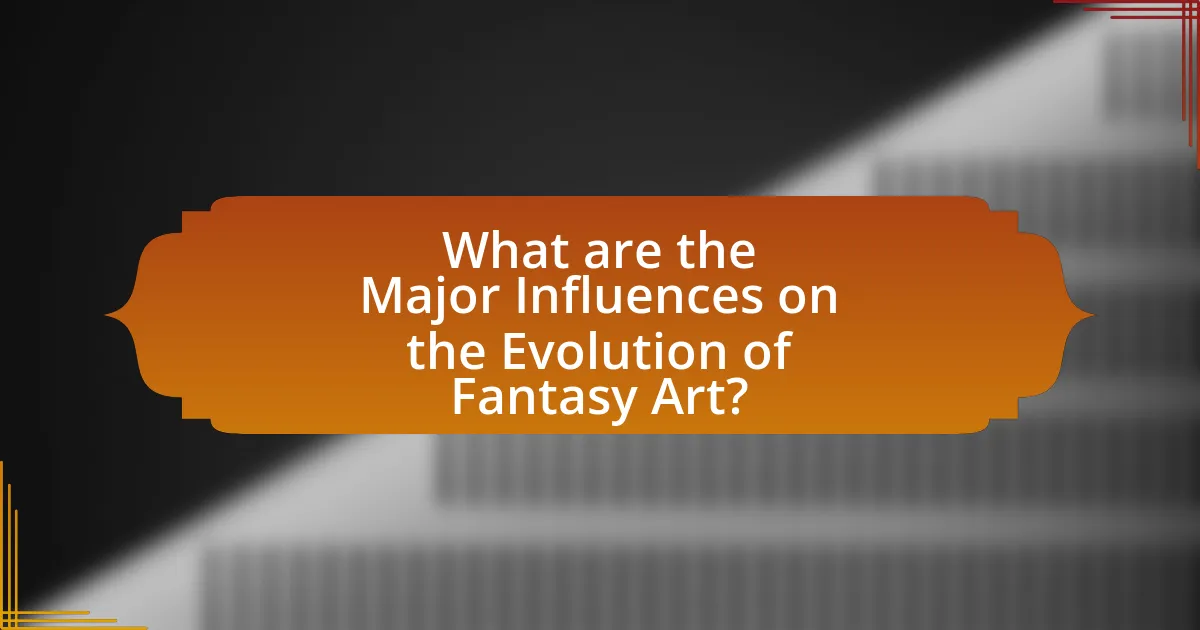
What are the Major Influences on the Evolution of Fantasy Art?
The major influences on the evolution of fantasy art include literature, mythology, and advancements in technology. Literature, particularly works by authors like J.R.R. Tolkien and C.S. Lewis, has shaped visual representations of fantastical worlds and characters, inspiring artists to create imagery that reflects these narratives. Mythology, encompassing various cultural stories and legends, has provided a rich source of themes and archetypes that artists draw upon, such as dragons, gods, and heroic quests. Additionally, advancements in technology, including digital art tools and platforms, have transformed how artists create and share their work, allowing for greater experimentation and accessibility in the fantasy art genre. These influences collectively contribute to the ongoing evolution of fantasy art, reflecting cultural shifts and technological progress.
How do literature and mythology impact fantasy art?
Literature and mythology significantly influence fantasy art by providing rich narratives, archetypes, and visual motifs that artists draw upon. Classic works, such as J.R.R. Tolkien’s “The Lord of the Rings,” inspire visual representations of fantastical landscapes and characters, while mythological sources like Greek and Norse myths offer a wealth of symbols and stories that shape the themes and aesthetics of fantasy art. For instance, the depiction of dragons in fantasy art can be traced back to various mythologies, where they symbolize power and chaos. This interconnection between literature, mythology, and visual art creates a dynamic dialogue that continues to evolve, as contemporary artists reinterpret these foundational narratives in innovative ways.
What literary works have inspired significant fantasy art movements?
Literary works that have inspired significant fantasy art movements include J.R.R. Tolkien’s “The Lord of the Rings,” C.S. Lewis’s “The Chronicles of Narnia,” and Lewis Carroll’s “Alice’s Adventures in Wonderland.” Tolkien’s richly detailed world-building and mythological elements have led to a vast array of visual interpretations, influencing artists like Alan Lee and John Howe. C.S. Lewis’s imaginative landscapes and characters have also been depicted in various artistic forms, contributing to the fantasy genre’s visual culture. Additionally, Carroll’s whimsical narrative has inspired countless illustrations and adaptations, showcasing the interplay between literature and visual art in the fantasy realm.
How do mythological themes manifest in visual art?
Mythological themes manifest in visual art through the depiction of gods, heroes, and legendary narratives that convey cultural values and beliefs. Artists often utilize symbolism, composition, and color to represent mythological stories, as seen in works like Botticelli’s “The Birth of Venus,” which illustrates the myth of Venus’s emergence from the sea, embodying beauty and love. Additionally, contemporary artists like Kehinde Wiley reinterpret these themes by placing figures from mythology in modern contexts, thereby bridging historical narratives with current societal issues. This ongoing engagement with mythology in visual art reflects its enduring significance in shaping human experience and cultural identity.
What role does popular culture play in shaping fantasy art?
Popular culture significantly influences the development and direction of fantasy art by providing themes, characters, and narratives that resonate with audiences. This influence is evident in the way fantasy art incorporates elements from movies, video games, and literature, which often serve as inspiration for artists. For instance, the success of franchises like “The Lord of the Rings” and “Game of Thrones” has led to a surge in artwork depicting their characters and settings, showcasing how popular media can drive trends in artistic representation. Additionally, the rise of digital platforms has allowed for the rapid dissemination of fantasy art, further intertwining it with popular culture and enabling artists to reach wider audiences who are familiar with these cultural references.
How have films and video games influenced fantasy art styles?
Films and video games have significantly influenced fantasy art styles by introducing dynamic visual storytelling and immersive world-building techniques. The cinematic techniques used in films, such as lighting, composition, and color grading, have inspired artists to create more dramatic and visually engaging fantasy scenes. For instance, the visual aesthetics of films like “The Lord of the Rings” have led to a rise in detailed landscapes and character designs in fantasy art. Similarly, video games like “The Elder Scrolls” series have popularized interactive environments and character customization, encouraging artists to explore diverse styles and perspectives. This cross-pollination of ideas has resulted in a richer, more varied fantasy art landscape that reflects the evolving narratives and technologies of both mediums.
What are the trends in fantasy art within the gaming industry?
Current trends in fantasy art within the gaming industry include a focus on hyper-realistic graphics, diverse character representation, and the integration of virtual reality (VR) elements. Hyper-realistic graphics have become increasingly popular as advancements in technology allow for more detailed and immersive environments, enhancing player engagement. Diverse character representation reflects a growing demand for inclusivity, with games featuring characters from various backgrounds and cultures, which broadens appeal and relatability. Additionally, the integration of VR elements in fantasy art creates interactive experiences, allowing players to engage with the game world in unprecedented ways, as seen in titles like “Half-Life: Alyx.” These trends demonstrate the industry’s commitment to evolving artistic standards and player expectations.
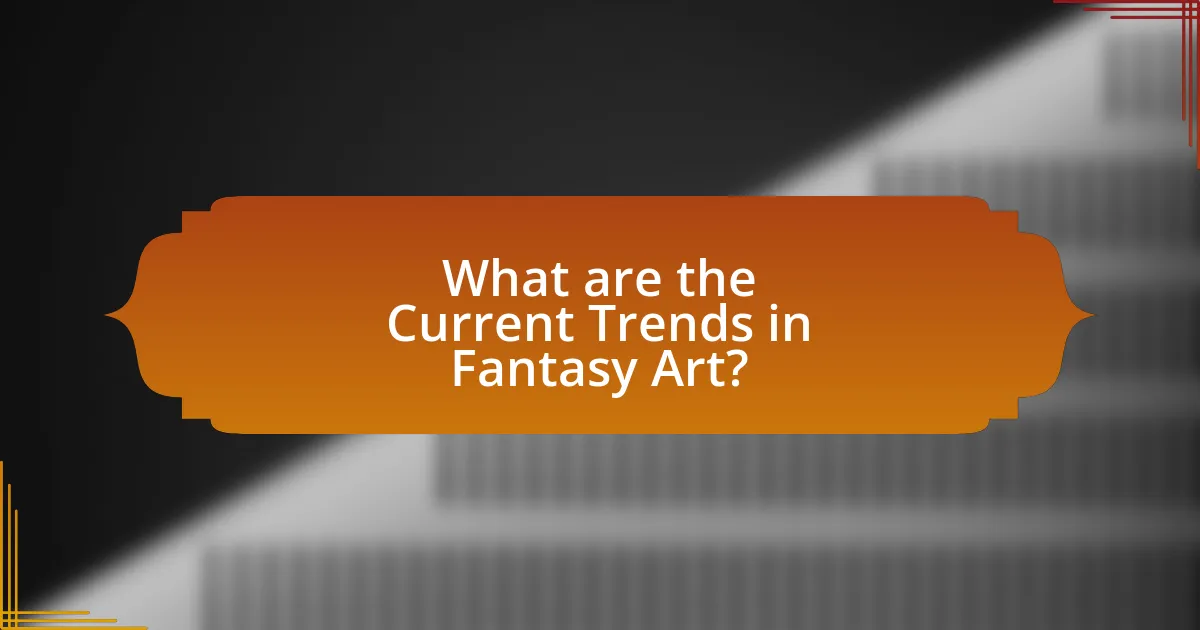
What are the Current Trends in Fantasy Art?
Current trends in fantasy art include a focus on digital mediums, diverse representation, and the blending of genres. Digital art has become predominant due to advancements in technology, allowing artists to create intricate and vibrant works with tools like Photoshop and Procreate. Additionally, there is an increasing emphasis on inclusivity, with artists showcasing a wider range of cultures, identities, and perspectives, reflecting a more globalized view of fantasy. The blending of genres, such as incorporating elements from science fiction or horror into traditional fantasy themes, is also gaining popularity, creating hybrid styles that appeal to broader audiences. These trends are supported by platforms like social media, where artists can share their work and connect with diverse communities, further influencing the evolution of the genre.
What are the emerging styles in contemporary fantasy art?
Emerging styles in contemporary fantasy art include digital painting, surrealism, and mixed media. Digital painting has gained prominence due to advancements in technology, allowing artists to create intricate and vibrant works that were previously difficult to achieve. Surrealism in fantasy art often blends dream-like elements with fantastical themes, pushing the boundaries of imagination and reality. Mixed media combines traditional techniques with digital elements, creating layered and textured artworks that engage viewers in new ways. These styles reflect the evolving nature of fantasy art, influenced by cultural shifts and technological innovations.
How do digital platforms affect the creation and distribution of fantasy art?
Digital platforms significantly enhance the creation and distribution of fantasy art by providing artists with accessible tools and global reach. These platforms, such as social media and online marketplaces, enable artists to create and share their work using digital software, which often includes advanced features for illustration and design. For instance, programs like Adobe Photoshop and Procreate allow for intricate detailing and rapid iteration, which traditional methods may not facilitate as efficiently.
Moreover, digital platforms facilitate the distribution of fantasy art by connecting artists directly with audiences worldwide, bypassing traditional gatekeepers like galleries and publishers. According to a 2021 survey by Artfinder, 70% of artists reported increased sales through online platforms, demonstrating the effectiveness of these channels in reaching potential buyers. This shift not only democratizes access to art but also fosters a diverse range of styles and voices within the fantasy genre, as artists can showcase their work to niche communities and receive immediate feedback.
What are the characteristics of popular contemporary fantasy artists?
Popular contemporary fantasy artists are characterized by their innovative use of digital technology, diverse thematic exploration, and a blend of traditional and modern artistic techniques. These artists often utilize digital tools like Photoshop and 3D modeling software to create intricate and immersive worlds, allowing for greater detail and flexibility in their work. Additionally, they explore a wide range of themes, including mythology, folklore, and personal narratives, reflecting contemporary societal issues and cultural diversity. The integration of various styles, such as realism and abstraction, further distinguishes their work, enabling them to appeal to a broad audience. This evolution in technique and thematic depth marks a significant shift from classic fantasy art, which often adhered to more rigid conventions and styles.
How is fantasy art being integrated into other art forms?
Fantasy art is being integrated into other art forms through collaborations in film, video games, literature, and digital media. For instance, fantasy art influences the visual aesthetics of blockbuster films like “The Lord of the Rings,” where concept artists create detailed illustrations that shape the film’s design. Additionally, video games such as “World of Warcraft” utilize fantasy art to develop immersive worlds, with artists crafting environments and characters that enhance gameplay. In literature, illustrated fantasy novels often feature artwork that complements the narrative, engaging readers visually. Furthermore, digital platforms allow artists to blend fantasy art with interactive experiences, such as virtual reality installations, showcasing the versatility and cross-disciplinary nature of fantasy art in contemporary culture.
What is the relationship between fantasy art and graphic novels?
Fantasy art and graphic novels are closely intertwined, as both utilize imaginative visuals to convey narratives, often set in fantastical worlds. Fantasy art serves as a foundational element in graphic novels, providing the visual style and thematic inspiration that define the genre. For instance, iconic graphic novels like “Sandman” by Neil Gaiman and “Saga” by Brian K. Vaughan heavily rely on fantasy art to create immersive environments and characters, showcasing the genre’s reliance on artistic interpretation of fantasy themes. This relationship is further evidenced by the collaboration between artists and writers in graphic novels, where the visual representation of fantasy elements enhances storytelling and engages readers.
How is fantasy art represented in modern installations and exhibitions?
Fantasy art is represented in modern installations and exhibitions through immersive environments, interactive displays, and multimedia elements that engage viewers. These contemporary approaches often incorporate technology, such as virtual reality and augmented reality, allowing audiences to experience fantastical worlds in a more dynamic way. For instance, exhibitions like “The Art of Video Games” at the Smithsonian American Art Museum showcased the intersection of gaming and art, highlighting how fantasy narratives are conveyed through visual storytelling. Additionally, artists like Yayoi Kusama and her Infinity Mirror Rooms create enveloping spaces that evoke a sense of wonder and fantasy, demonstrating how modern installations can transform perceptions of reality.
What practical tips can aspiring fantasy artists follow?
Aspiring fantasy artists should practice regularly to improve their skills and develop their unique style. Consistent practice allows artists to refine their techniques, explore different mediums, and gain confidence in their abilities. Additionally, studying the works of established fantasy artists can provide inspiration and insight into effective composition, color theory, and character design. Engaging with online communities and seeking constructive feedback can further enhance an artist’s growth by exposing them to diverse perspectives and critiques. Lastly, creating a portfolio that showcases a range of works can help aspiring artists attract potential clients and opportunities in the competitive fantasy art market.
How can artists develop their unique style in fantasy art?
Artists can develop their unique style in fantasy art by experimenting with various techniques, themes, and influences while consistently practicing their craft. Engaging with diverse artistic movements, studying the works of established fantasy artists, and incorporating personal experiences can help artists identify what resonates with them. For instance, artists like Brian Froud and Julie Bell have distinct styles that emerged from their unique interpretations of fantasy themes and personal artistic journeys. By analyzing their approaches, artists can draw inspiration and adapt elements that align with their vision, ultimately leading to the formation of a unique artistic identity in the fantasy genre.
What resources are available for learning fantasy art techniques?
Resources available for learning fantasy art techniques include online platforms, books, and workshops. Websites like Skillshare and Udemy offer courses specifically focused on fantasy art, covering various techniques and styles. Additionally, books such as “Fantasy Art Workshop” by John Howe and “The Art of Fantasy” by Michael Whelan provide in-depth insights and practical exercises. Workshops and conventions, such as the Spectrum Fantastic Art Live, also offer hands-on learning experiences and networking opportunities with established artists in the fantasy genre. These resources collectively support the development of skills in fantasy art.
